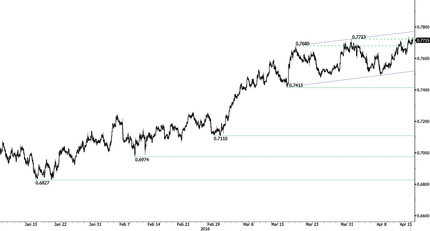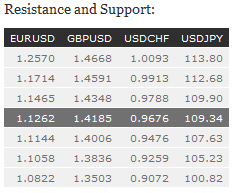Forex News and Events
China’s economy stabilise in the first quarter (by Arnaud Masset)
From our standpoint the latest batch of economic data from China was rather encouraging as it proved that China’s dragon still has some fire in its belly, The economy gained 6.7%y/y in the first quarter, down from 6.8% in Q4 2015 but still matching market expectations. The stabilisation came on the back of a rebound in the property sector as the total investment in real estate development reached CNY 1,768bn, corresponding to a real growth of 9.1% year-over-year.
On the inflation front, the consumer price index rose 2.1%y/y in the first quarter compared to 1.5% in the final quarter of 2016 as food prices continue to steadily grow. However, the producer prices for industrial products contracted 4.8%y/y in 3Q, signaling that the manufacturing sector is not out of the woods just yet.
Finally, March industrial production grew 6.8% year-over-year, beating expectations of 5.9%. In the March quarter, the gauge rose 5.8%y/y compared to 5.4% in the previous quarter, above median forecasts of 5.5%.
All in all, the data released by the National Bureau of Statistics is quite encouraging and may suggest that the Chinese economy is successfully adjusting to the “new normal”. However, we think it is still a little premature to draw any real conclusions as nothing has essentially changed; what we are seeing may be simply a pause before further downside adjustment as China still faces rising debt in its corporate sector and industrial overcapacity. The positive trend in inflationary pressure suggests that easing is less likely, especially in light of recent signs of stabilisation. The PBoC will therefore maintain its easing bias but we doubt it will deliver further interest rate cuts and/or reserve requirement ratio. Overall, the ongoing slowdown of the Chinese economy will weigh further on the global economy and we will not be surprised if we see a correction of most commodity currencies such as the Aussie and the Kiwi over the course of the coming weeks.
Russian industrial production at stake amid lingering low imports (by Yann Quelenn)
Markets expect Russian industrial production to recover. March data is forecasted at -1% y/y declining from February when it rebounded at 1% y/y. Remember that in the course of last year, industrial production fell by 3.4% y/y and that during the same time frame, imports collapsed, diminishing by 40%. It therefore follows that the domestic economy has not managed to fill the gap left empty by the lesser quantity of western goods. In other words, additional parts of the economy are at stake and when looking at the fundamentals, massive inflation and low commodities prices continue (despite recent rebound) to weigh on the country. It also signals that Russian’s reliance on commodities is greater than what was believed by the financial markets.
The ruble is nevertheless strengthening against the greenback. One dollar is worth just over 66 ruble. The current rebound in oil prices is pushing Russian stocks higher and the currency keeps on appreciating. Finally, the Fed's dovish stance should benefit the Russian currency and we believe the ruble will continue to strengthen.
EM enters a Goldilocks regime (by Peter Rosenstreich)
Encouraging economic data out of China is just one more reason to expect the rally in emerging-market currencies to continue. Other key factors include the dominant view of a shallow fed rate path (along broader accommodating central bank policies), recovery in many EM nations economic data since Q3 2015 and steady improvement in commodity prices. As a result EM credit has witnessed significant demand as capital continues to search for yields and macro continues to remain favorable. However, the sustainability of this rally should soon be brought into question as a portion of the rally has been driven by improvements on the domestic economic front due to weak currencies. The fundamental rationale for this EM rally has always been questioned. There is a possibility that against a weak international backdrop, data improvement is purely a function of currency weakness. Therefore, a stronger currency could derail the current promising situation.
In the current environment we remain optimistic on the Mexican peso. Weak domestic conditions look to have bottomed since last year. Last week, data indicated that industrial production decreased 0.1% m/m, above expectations, with positive expansion in manufacturing. The read suggested that deceleration was short-lived and correlated with the US own pullback in PMI reads. Mexico is on track for 2.3% GDP growth in 2016 as domestic demand remains resilient. On the government side, Banco de Mexico pronounced an allocation of MXN239bn ($13.6bn) in excess funds to the federal government for use in reducing public debt in light of lower oil revenues. The move should help support investor confidence in the wake of Moody downgrading the outlook for Mexico’s sovereign debt rating to negative from stable due to weak economic growth and fragility in public finances. However, the most compelling reason to buy MXN is sustained correlation of oil and peso. Despite the expected absence of a deal in Doha steady global productions cuts and lack of capex should allow oil prices to grind higher. Our view that additional supply could come on line quickly as prices increase has been weakened as access to credit has become more complex. USD/MXN traders should target 16.50 support.
AUD/USD - 0.7800 Is On Target.


EUR/USD is now consolidation after recent weakening. However, pair is still moving within a horizontal range defined by the key support area between 1.1144 (24/03/2016 low) and resistance at 1.1465 (12/04/2016 high). Stronger support is located a 1.1058 (16/03/2016 low). Expected to show further range-bound pattern. In the longer term, the technical structure favours a bearish bias as long as resistance at 1.1746 ( holds. Key resistance is located at 1.1640 (11/11/2005 low). The current technical appreciation implies a gradual increase.
GBP/USD is riding downtrend channel near the hourly support at 1.4006 (04/06/2016 low). Hourly resistance is given at 1.4320 (04/04/2016 high). Expected to show further weakening. The long-term technical pattern is negative and favours a further decline towards key support at 1.3503 (23/01/2009 low), as long as prices remain below the resistance at 1.5340/64 (04/11/2015 low see also the 200 day moving average). However, the general oversold conditions and the recent pick-up in buying interest pave the way for a rebound.
USD/JPY keeps on reversing but the pair has failed to break hourly resistance at 109.90 (07/04/2016 high). Short-term selling pressures are weakening but are still on. Hourly support can be located at 107.68 (07/04/2016 low). Expected to show further increase. We favour a long-term bearish bias. Support at 105.23 (15/10/2014 low) is on target. A gradual rise towards the major resistance at 135.15 (01/02/2002 high) seems now less likely. Another key support can be found at 105.23 (15/10/2014 low).
USD/CHF is moving sideways without massive volatility. Hourly support can be found at 0.9499 (12/04/2016 low). Further resistance is located at 0.9688 (intraday high) and 0.9788 (25/03/2016 high). Expected to show further increase as short-term selling pressures do not seem strong. In the long-term, the pair is setting highs since mid-2015. Key support can be found 0.8986 (30/01/2015 low). The technical structure favours a long term bullish bias.

